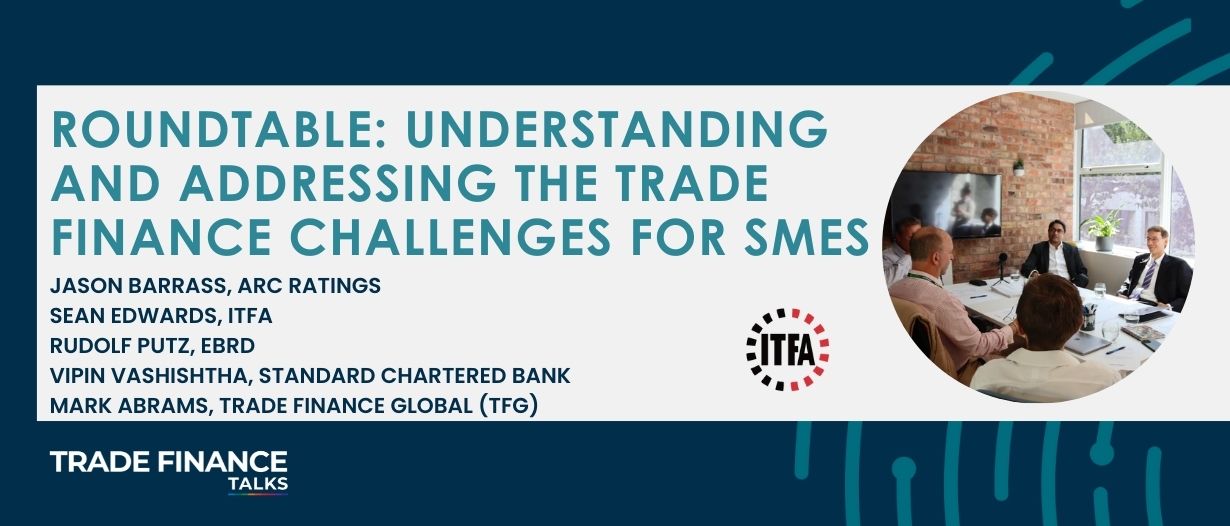- Jason Barrass, Chief Commercial Officer, ARC Ratings
- Sean Edwards, Chairman, ITFA
- Rudolf Putz, Head of the Trade Facilitation Programme, EBRD
- Vipin Vashishtha, Managing Director and Global Head of Trade Asset Sales & Syndications, Standard Chartered Bank
- Mark Abrams, Global Head of Trade & Receivables Finance, Trade Finance Global (TFG)
Moderated by Deepesh Patel, editor, Trade Finance Global
This year’s ITFA 48th Annual Trade & Forfaiting conference, held in Porto, covered a few key themes, one of the most notable being the increasing trade finance gap, which impacts small- to medium-sized enterprises (SMEs) in emerging markets the most.
The figures are stark. An unmet trade finance need of $1.7 trillion stands – that’s the pre-pandemic level – and SMEs are rejected for trade finance 40% of the time.
Given the counter-cyclical nature of trade finance, boosting access will be critical for global economic recovery following the slowdown from COVID-19 and more recently, the grappling inflationary effects caused by the Russia-Ukraine crisis.
Back in London, TFG gathered four industry leaders to discuss these issues at length: Jason Barrass, chief commercial officer at ARC Ratings; Sean Edwards, chairman at ITFA; Rudolf Putz, head of the trade facilitation programme at the European Bank for Reconstruction and Development (EBRD); Vipin Vashishtha, managing director and global head of trade asset sales and syndications at Standard Chartered Bank; and Mark Abrams, global head of trade and receivables finance, TFG.
The challenges of trade finance are multidimensional
When it comes to trade finance challenges, many observers claim that lenders are unwilling to provide capital.
The situation on the ground, however, is not so straightforward.
In many instances, larger banks are doubling down on distribution efforts to help free up capital, whilst multilaterals are increasing their support to help provide guarantees to smaller local and regional banks that tend to directly finance SMEs.
“For most banks, direct lending becomes constrained as you go down the credit curve given the capital implications,” Vashishtha said.
“But banks and the industry is working towards enhancing supplier financing capabilities and other innovative solutions such as securitisation portfolios with alternative investors to bring in additional liquidity; I think this is one of the critical enablers for us to finance SMEs in a larger way.”
For multilaterals and international financial institutions (IFIs), there has been a growing problem with declining relationships between correspondent and respondent banks in recent years – where risk appetites are constantly ebbing and flowing due to a variety of factors that are often invisible to businesses seeking funding.

The traditional nature of trade finance
The trade finance industry generally understands that banks alone will be unable to address the global unmet demand.
This is because, with limited capital available, credit departments are naturally incentivised to allocate capital to less “risky” deals to generate safer returns.
At the moment, such trade finance transactions are not able to be sold onto secondary (non-trade) markets, a quirk that sharply contrasts the trade finance asset class with other industries.
Barrass said, “Many other industries have investors – non-trade finance investors – that will come in and buy distressed assets because they have different coupon returns on those assets.
“There is still a hunt for yield among non-trade investors who are willing to look at ‘alternative’ asset classes. The yield in trade has been attractive and interest in the assets class has grown.
“In trade finance, we haven’t embraced the use of securitisation tools to structure assets in a way that provides comfort to asset managers and pension funds.”
“We haven’t used securitisation tools to structure assets in a way that provides comfort through higher coupon rates.”
Trade finance as an asset class remains poorly understood by many institutional investors, who at the same time, are looking for low-risk, uncorrelated short-term assets which give positive yield and finance the real economy. Scaleability is also difficult, given the challenges around replenishing the trade assets.
Edwards said, “My take on it is that we haven’t got a lot better at serving those SMEs. We’ve got better tools for doing it, but we haven’t actually gone to the next step.
“ITFA hope to address this with its ITFA Trade Finance Investment Ecosystem (ITFIE), which launched earlier this year.”
The ITFIE aims to advance the evolution of trade finance as an asset class for alternative investors by developing a standardised framework, creating a legal directory, defining a technological framework for trade finance and bridging the communication gap between institutional investors and trade finance world.
ITFA’s vision for this initiative is to attract investment from asset managers, insurance companies, pension funds, and others who seek a risk-return profile that aligns with the character of trade finance portfolios.
Practical strategies for addressing trade finance challenges
One approach that has proven effective in addressing some of these challenges has been leveraging digital tools to create platforms around instruments like supply chain finance.
As these platforms grow and onboarding methods become more streamlined, they will become more appealing to mainstream investors that may have otherwise avoided deploying capital in this market.
Multilateral organisations, such as the European Bank for Reconstruction and Development’s (EBRD) trade facilitation program (TFP), have also been pivotal in driving the sector’s financing.
Putz said: “We support partner banks in 30 countries of EBRD’s countries to help them develop their trade finance businesses.
“We provide them with technical assistance, training, guarantee facilities and loan facilities for on-lending to importers and exporters.”
Many experts believe that programmes like EBRD’s TFP will continue to generate growing benefits if multilaterals provide more risk cover to underlying transactions through their partner banks.
Driving increasing capital into the market will require banks and other institutions to embrace this degree of partnership to serve client needs best – moving away from the outdated approach that the bank should be a one-stop shop for all client needs.
Even in instances where a bank cannot finance a client’s transaction fully, they must still put in the effort to facilitate that transaction, whether it means referring the client to another bank that has the capacity or partnering with a development organisation that can absorb some of the risks.
Approaches that have proven ineffective
Implementing regulatory constraints is one approach that has not worked at bringing liquidity into trade finance.
This largely stems from the origin of these regulations – coming from outside the industry and with little opportunity for those actively involved in the space to enact meaningful changes based on their years of expert experience.
The treatment of off-balance sheet instruments provides an excellent example.
With the phased introduction of Basel III reforms, the European Commission’s amendments to the Capital Requirements Regulation (CRR) have proposed that off-balance sheet instruments – such as guarantees or standby letters of credit – be categorised as medium-risk.
This means that the required credit conversion factor for these fundamental trade finance products would rise from 20% to 50%, suddenly making them much riskier in the eyes of financial institutions and thus much more expensive for end clients.
While many organisations and practitioners within the industry have been lobbying against these changes, external regulators require vast amounts of data demonstrating a specific trend before they will explore changes to the regulations.
Trade finance does collect data, but data protection issues and a lack of standardisation make it difficult for industry practitioners to use data to convincingly demonstrate a need to adapt the governing regulation.
Transparency – the key challenge
“Transparency––or lack of it––in trade finance is one of the key challenges highlighted by many alternative investors,” Vashishtha said.
The same risk is often priced drastically differently by different institutions with little to no consistency in the processes used.
For an assortment of historical reasons, the trade finance market has not evolved to that level of consistency and standardisation.
“Until we address that, we would struggle to have the required institutional funders coming in due to the discomfort in joining a space that is not transparent,” Vashishtha added.
Fortunately, would-be investors do not necessarily need to have a clear grasp of the intricacies of trade and trade finance – but they will need more than they have access to now.
“An outside investor is not going to understand trade operational risk, but they’re not interested in understanding that,” Barrass said.
“An alternative investor does not understand the nuances of trade finance, its terminology and certain elements of the risk, such as fraud or documentary, but they do understand the comparable risk if its rated BBB.
“This is where openness and transparency are required to help commercialise trade as an alternative asset class.”
Importing and exporting companies need to be willing to provide banks, credit insurers, or data companies with access to data on their transactions.
With widespread access to data of this nature, the industry will be able to develop a credit risk rating system that outside investors can use to compare unfamiliar trade finance transactions with the deals that they engage with every day.

Education, education, education
The common consensus during the roundtable, however, stood at an industry need to continue providing advocacy and education to corporates and SMEs alike.
On a practical level, SMEs in the market do not care what technology their bank uses to facilitate their requests; they don’t care what platform their bank is a member of; they likely don’t even care which bank puts its name on the documents.
They may care about the simplicity of only needing to use a single platform, but their biggest concern at the end of the day is that the liquidity is there and that it is at the right cost.
Abrams said: “What we see at TFG is that there are around 20 different structures, from pre-export trade loans to receivables, and there is a general such a lack of understanding amongst companies about which desk to go to at their bank.”
Technologists and financiers need to understand that, no matter what solution they hatch up in digital innovation labs, they need to ensure that it does not overcomplicate and thus hinder their commitment to serving the clients that rely on them most.





























